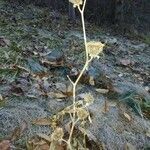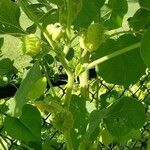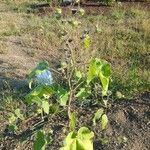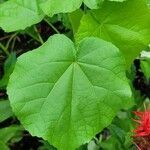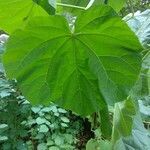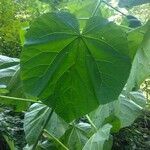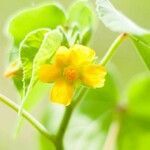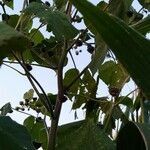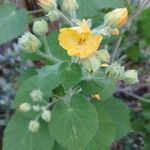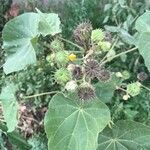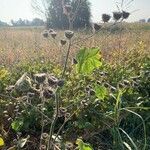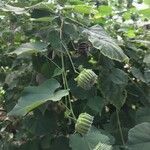Erect annual herb, 0.3-1-(1.5) m high. Stems densely hairy with short erect simple hairs and stellate hairs of equal length above, but mostly fine stellate hairs below, becoming somewhat woody at base. Lvs densely clothed in fine stellate hairs, velvety to touch, slightly lighter green below, broadly ovate to suborbicular, acuminate, cordate to almost sagittate at base, not lobed, serrate, 3-15 cm long; petioles 2-15 cm long; stipules linear, c. 10 mm long, deciduous. Fls axillary and solitary or in irregular axillary infls; fruiting pedicels 1-15 cm long; calyx shallowly campanulate; calyx teeth much > tube, ovate-triangular, acute to acuminate, densely clothed in stellate hairs, ± unchanged at fruiting; petals yellow, 7-13 mm long. Cells c. 13 per fr., covered in fine stellate hairs and with long stellate hairs particularly along the ridged back; dorsal apical angle with a long slender awn. Seeds brown, hairy, c. 3 mm diam.
Herbs subshrublike, annual, 1-2 m tall. Petiole 3-12 cm, stellate hairy; leaf blade orbicular-cordate, 5-10 cm in diam., both surfaces densely stellate pubescent, base cordate, margin minutely crenate, apex long acuminate. Flowers solitary, axillary, yellow. Pedicel 1-3 cm, pubescent, articulate near apex. Calyx cup-shaped, densely puberulent, lobes 5, ovate, ca. 6 mm. Corolla uniformly yellow; petals obovate, ca. 1 cm. Filament tube glabrous. Ovary 15-20-loculed, 1-1.5 cm, densely pubescent, apex truncate. Capsule semiglobose, ca. 1.2 × 2 cm; mericarps 15-20, stellate pilose, apex 2-awned, awns spreading, 3-5 mm, hairy. Seed reniform, brown, stellate puberulent. Fl. Jul-Aug.
Herbs, annual, to 1+ m. Stems erect, stellate-tomentose, without simple hairs. Leaves: stipules lanceolate; petiole subequal to blade; blade concolorous, broadly ovate to suborbiculate, 8–15 cm, ± as long as wide, base cordate, margins crenulate, apex acuminate, surfaces softly pubescent. Inflorescences usually solitary flowers, sometimes cymose or racemose. Flowers: calyx 10 mm, lobes not overlapping, erect in fruit, ovate; corolla pale yellow throughout, petals 8–13 mm; staminal column glabrous; style 13–15-branched. Schizocarps broadly ovoid, 15 × 20 mm; mericarps: apex spinose, spines divergent, 3–6 mm, hirsute. Seeds 3 per mericarp, 3–4 mm, minutely puberulent. 2n = 84.
Stout branching annual 1–1.5 m, softly hairy throughout with few-armed stellate hairs; lvs cordate, 10–15 cm long and wide, acuminate, entire or obscurely toothed, on petioles about as long; peduncles joined above the middle, elongating to 2–3 cm at maturity; fls yellow, 1.5–2.5 cm wide; head of fr 2–3 cm wide; carpels commonly 10–15, densely hairy, with conspicuous horizontally spreading beaks; 2n=42. Native of s. Asia, established as a weed in fields and waste places nearly throughout our range but more abundant southward. July–Oct. (A. abutilon)
An annual plant about 1 m high. The leaf stalk is 3-12 cm long. The leaf blade is almost round and 5-10 cm across. It is densely hairy. There are small teeth along the edge. It tapers to the tip. The flowers are yellow and occur singly in the axils of leaves. The fruit are capsules that are a flattened round shape and 1.2 cm logn by 2 cm across. The seeds are brown and kidney shaped.
